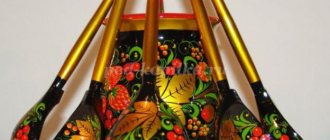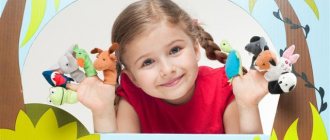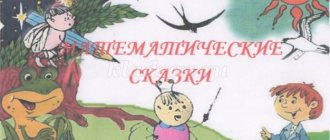Oral folk art as a means of education and development of preschool children
Oral folk art contains inexhaustible opportunities for the development of speech skills, which make it possible to encourage children to be active in speech from an early age.
Works of folklore, with their content and form, best meet the tasks of child upbringing and development and are adapted to children's needs. Little by little, imperceptibly, they introduce the child into the element of the folk word, reveal its richness and beauty, and serve as a model of speech [6, p. 26].
An important period in a child's development is preschool age. It is difficult to overestimate the role of oral folk art in the education and development of the personality of a young child. One of the first works of art that a child is able to perceive are small forms of folklore. Thanks to them, adults can easily establish emotional contact with a child, broaden their horizons, form an attitude towards the world around them, and enrich their speech. Folk art is also an important source of moral, aesthetic, and patriotic education of preschool children.
Works of oral folk art are the first things a child hears and reproduces in life. These are lullabies, nursery rhymes, pesters. In the course of introducing this type of folk art, educational tasks such as:
- develop the child’s interest in oral folk art;
‒ develop expressiveness in the child’s language, intonation, strength of voice, colloquial speech, and also, through living figurative language, teach understanding of words and expressions;
- reveal to children the meaning of proverbs and sayings, which contain rules of behavior and moral standards;
- with the help of Russian folklore, as well as the folklore of other peoples, to enrich children’s knowledge about the world around them;
- learn to role-play fairy tales;
- to interest children in folk games, to teach them to use folklore for independent play and theatrical activities.
Fairy tales, sayings, riddles contribute to the development of thinking, imagination, intelligence, and the development of the emotional sphere. Russian folk works themselves are rich in form and content and initially contain moral values.
Fairy tales are one of the components used in interaction with children; they play a special role in raising children, and they are also most interesting for preschool children. The simplicity and directness of presentation of this genre of folk art is most attractive and understandable for a child’s perception and understanding. Using the example of fairy tale characters, a child easily becomes acquainted with such concepts as good and evil, greed and generosity, courage and cowardice, etc. When giving an assessment to fairy tale heroes, children analyze which actions committed by the characters are positive and which are negative. They experience a wide range of feelings with them, and having taken one side or another, they try, together with the heroes of the work, to solve all the tasks assigned to him, which also helps to increase the child’s creative activity and makes it possible to draw the right conclusion in a given situation.
At preschool age, children are very vulnerable, and it is the fairy tales of Russian folk art that are that unique means of easily telling children about the negative things in life, drawing an analogy and comparing it with the real world. But we must not forget that educators and parents need to carefully and competently approach the selection of works in accordance with the age characteristics of the children and the goals that need to be achieved.
They help show children: how good helps to defeat evil (“Zimovye”); how the good and peace-loving win (“The Wolf and the Seven Little Goats”); that evil is punishable (“The Cat, the Rooster and the Fox,” “Zayushkina’s Hut”). Moral values are presented more specifically in fairy tales than in animal tales. Positive heroes, as a rule, are endowed with courage, courage, perseverance in achieving goals, beauty, captivating directness, honesty and other physical and moral qualities that have the highest value in the eyes of the people. For girls - a beautiful maiden (clever, needlewoman), and for boys - a kind young man (brave, strong, honest, kind, loving his homeland). The ideal for a child is a distant prospect, to which he will strive, comparing his deeds and actions with the ideal. The ideal acquired in childhood will largely determine him as a person. The fairy tale does not give direct instructions to children (such as “Listen to your parents,” “Respect your elders,” “Don’t leave home without permission”), but its content always contains a lesson that they gradually perceive, repeatedly returning to the text of the fairy tale. Moral education is possible through all types of folk tales, because morality is initially inherent in their plots [9, p. 31].
The educational value contained in works of folk art has a special influence on the formation of patriotic feelings. Carrying specific images and colors that are accessible and attractive to preschool children, the works serve as a means of a child’s positive attitude towards various aspects of social life. It is very important to introduce preschoolers to magical and heroic fairy tales. The idea contained in them about the feat of heroes in the name of liberating their native land from enemies helps to reveal the ideas of patriotism.
Proverbs and sayings are perfect for developing moral values in children, since they are emotionally rich and sometimes contain moral postulates. These short sayings are easily remembered by children; their impact on the child is stronger than ordinary persuasion and moralizing. Tongue twisters help a child learn to speak correctly and quickly and at the same time remain a simple game for them.
During this period, those feelings and character traits begin to develop that invisibly connect the child with his people. The roots of this connection are in the language of the people, their songs, music, games, in the impressions a little person receives from the nature of his native land, in the details of everyday life, the morals and customs of the people among whom he lives. Folk art is an inexhaustible source of pedagogical material, one of the foundations of speech, moral, aesthetic, and patriotic education. The use of the cultural heritage of the Russian people in work with preschoolers and their mastery of the cultural heritage of the Russian people creates interest in it, enlivens the pedagogical process, and has a special impact on the emotional and moral aspects of the individual [2, p. 4].
Children's reading includes Russian folklore, as well as folklore of the peoples of the world. They carry the great potential of national and folk cultures and make the child the owner of universal spiritual values. In his literary development, a child must move from the literature of his people to children's world literature [6, p. 27].
In kindergarten, a favorable environment is created for listening, repeating and playing nursery rhymes, which contributes to the development of the child’s speech and memory. To enrich children's vocabulary, it is very advisable to use nursery rhymes. These short poems are often complemented by certain actions that help foster goodwill and empathy. Over time, children transfer them to independent games. Thanks to nursery rhymes, children learn to perceive a short story expressed in literary words.
From an early age, children can happily look at pictures, illustrations of books or educational games based on folklore works and retell them.
The use of various types of oral folk art together with other educational means will help to successfully enrich the child’s vocabulary, develop his speech activity, and help in the formation of a harmoniously developed personality. What a child absorbs in preschool age mainly depends on the environment in which he is raised. By surrounding children with their care and affection, as well as including oral folk art in their classes, parents, teachers, and educators can instill in them from an early age the basic moral qualities that will only develop in their later lives.
Literature:
- Alekseeva M. M., Yashina V. I. Methods of speech development and teaching the native language of preschoolers: a textbook for students. higher and Wednesday ped. textbook institutions / M. M. Alekseeva, V. I. Yashina. - M.: Publishing House, 2000. - 400 p.
- Vikulina A. M. Elements of Russian folk culture in the pedagogical process of a preschool institution / A. M. Vikulina. - N. Novgorod: Nizhny Novgorod Humanitarian Center, 1995. - 138 p.
- Volkov G. N. Ethnopedagogy: a textbook for students. higher and Wednesday ped. textbook Establishments / G. N. Volkov. - M.: Publishing House, 1999. - 168 p.
- Gavrilova I. G. Origins of Russian folk culture in kindergarten: methodological manual / I. G. Gavrilova. - SPb.: DETSTVO-PRESS, 2010. - 160 p.
- Gavrish N. Use of small folklore forms / N. Gavrish // Preschool education. - 1991, No. 9 - pp. 16–20.
- Gurovich L. M., Beregovaya L. B., Loginova V. I., Piradova V. I. The child and the book: a manual for kindergarten teachers / L. M. Gurovich, L. B. Beregovaya, V. I. Loginova , V. I. Piradova. - SPb.: DETSTVO-PRESS, 2000. - 128 p.
- Doronova T. N. Development of young children in the conditions of variable preschool education / T. N. Doronova. - M.: Obruch, 2010. - pp. 119–127
- Zimina I. Folk tale in the system of education of preschool children / N. Zimina // Preschool education. - 2005, No. 1 - pp. 18–28.
- Zimina I. Folk tale in the system of education of preschool children / N. Zimina // Preschool education. - 2005, No. 5 - pp. 28–35.
- Kuprina L. S., Budarina T. A. et al. Acquaintance of children with Russian folk art / L. S. Kuprina, T. A. Budarina et al. - St. Petersburg: DETSTVO-PRESS, 2001. - 400 p.
- Lyalina L. A. Folk games in kindergarten: methodological recommendations / L. A. Lyalina. - M.: TC Sfera, 2009. - 96 p.
- Mukhina V. S. Developmental psychology, phenomenology of development, childhood, adolescence: a textbook for students. universities - 4th ed. / V. S. Mukhina. - M.: Publishing House, 1999. - 456 p.
- Pidruchnaya S. Fairy tales - for the safety of children / S. Pidruchnaya // Preschool education. - 2008, No. 2 - pp. 124–127.
- Poshtareva T. The use of folk tales in the educational process / T. Poshtareva // Preschool education. - 2009, No. 5 - pp. 24–28.
- Khalikova R. Folk art as a means of instilling love for the native land / R. Khalikova // Preschool education. - 1988, No. 5 - pp. 13–17.
Counting book as a genre of playful children's folklore
The counting table is a type of Russian gaming folklore. The first scientific work that paid close attention to this particular genre was the monograph “Russian Children's Folklore” published in 1930. Its author is Doctor of Philology G.S. Vinogradov. It contains more than 500 counting rhymes.
In 1989, the collection of folklorist A. N. Martynova, “Rhymes, Counting Countries, Fables,” was published, which is considered the most complete publication of these genres . In addition, counting rhymes can be found in the following publications:
- “Children's counting rhymes. Set for mom." 2010
- “A suitcase floated on the sea”, 2015
- “I went out for a walk for a month.” 2009
Counting books remain a popular genre in children's books today.
The distinctive features of the counting rhymes are:
- Practical applicability. Counting tables have a clear task: with their help, they choose the driver of the game, distribute roles or players among teams.
- Rhythm. If there is no rhythm in the counting rhyme, it will be very difficult to divide it into words or syllables, and the child reading it will get confused .
- Rhyming. Counting books in poetic form are easier to remember, and this was a definite plus in those days when books were not available to everyone.
- Brevity, information richness. It is these qualities that make the reading room a valuable material for broadening the horizons of children, familiarizing themselves with folk traditions and foundations.
The child gets acquainted with the first counting rhymes by counting his own fingers.






